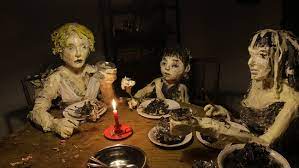
c/o The Hollywood Reporter
Content Warning: This article contains spoilers, as well as mentions of pedophilia, sexual assault, and a swastika.
There are few films that have remained stationary in my mind, like the Chilean film “The Wolf House,” or “La Casa de Lobo” (2018), by directors Cristobal León and Joaquín Cociña. Screened at the Wesleyan Film Series on October 28, the film weaves together visual art, narrative, and a historical period which is truly frightening to create one of the most unsettling horror movies I have ever seen.
“The Wolf House” incorporates elements of a wide range of artistic forms. Throughout the film, the audience witnesses sculpture, painting, collage, drawing, and more, all through stop-motion animation. A central part of the horror is the disassembly of these sculptures, where it is clear that the uncanny valley is at play. The protagonist Maria and her pigs (who gradually turn into children) are the main characters of this story and are never truly human but remain on the cusp of personhood in a fairytale-like alternative reality that never becomes wholly real.
The story is told like a fairytale. Maria, who has escaped from a settlement for releasing some pigs from their pen out into the woods, has been punished by being made to stay silent for 100 days. She ventures out into the forest beyond the village, where she finds a house, unoccupied but outfitted with furniture, art, and even a television. Although it is clear that people once inhabited the house, nobody lives there anymore; bugs crawl out of the shelves like they have been living there for a long time. She decides to occupy this home and turns the two pigs in the house that she finds into two children, Ana and Pedro. After burning the children accidentally, Maria feeds them magical honey which makes them sprout blonde hair and turns their eyes blue. From here, the plot devolves according to fairytale convention—the story ends with Maria and Pedro attempting to eat Maria. The whole movie is overshadowed by the character of the wolf, who never truly appears to the audience, but rather is heard, booming throughout scenes and seen at one point as a giant eye projected on one of the walls, like Big Brother from “1984”.
This story is prefaced by what seems to be a promotional film of a community called “La Colonia.” La Colonia appears to be a closed German community located in the mountains of Chile. Interspersed with pictures of an idyllic community are pictures of people in the hospital caring for their Chilean neighbors, describing the relationship between the two groups as harmonious. While the fairytale, which comes later, may be more outwardly horrific, this aspect had a creepier resonance in the constructed perfection of a community purporting to be a utopia. This introduction sets up the footage of Maria’s story as a film that members of La Colonia have recovered.
The film’s style is surreal, haunting, and disturbing. Insects crawl out of walls, eyes turn black, and bodies crumple like the tape puppets that they are. At one point, a picture bleeds with black blood. The bodies of the three characters are inherently monstrous in their construction, in the way that they are constantly shifting forms but never completely gain humanity.
The movie is also multilingual. Maria, who also serves as narrator, alternates between German and German-inflected Spanish. The shifting languages place the narrator into a setting that is both unknown and known at the same time. While the temporality of the place is purposefully vague, the combination of German and Spanish conjures up the movement of Nazis to South America after World War II. These references are not completely veiled: a swastika drawn on the wall turns into a window at one point. There is also reference to Aryan values, such as when Maria feeds Ana and Pedro to help heal their wounds to make them “pretty and strong,” and when it heals them, it makes them blonde and blue-eyed.
This film also draws from a very real history, which I was anxious to discover as soon as the screening ended. None of the actual history is directly referenced in the film, so it took a bit of googling to find the story that it was based on. For one, the film nods to La Colonia Dignidad, a cult formed in 1961 by Paul Schäfer, which brought a contingency of German citizens to central Chile. Schafer was a charged pedophile who abused children in an orphanage which he founded and continued to do so when he moved to Chile. This settlement was a tax-exempt, supposedly communal paradise hidden in the isolated Chilean mountains. However, in reality, it was a Nazi cult that perpetuated child sexual abuse, torturing of the Pinochet government’s political opposition, and violence. Surveillance, guards, and a prison-like environment were central to Schäfer’s cult. Only a few people escaped from the group in the 30-year-span that it existed. Josef Mengele, the infamous Nazi doctor who performed dozens of fatal experiments on concentration camp prisoners, was supposedly also present in this community for some period of time. The cult was known for its prohibition of sex, its separation of women and men, and the way they called Schäfer “The Permanant Uncle”. Since then, Colonia Dignidad has been transformed into a resort, named “Villa Baviera,” which has only slightly begun to reconcile its tragic and horrible history.
The story of “The Wolf House,” a film that is already rich with history, art, and symbolism, only becomes more haunting with this context.
Annika Shiffer-Delegard can be reached at ashifferdele@wesleyan.edu.
Comments are closed